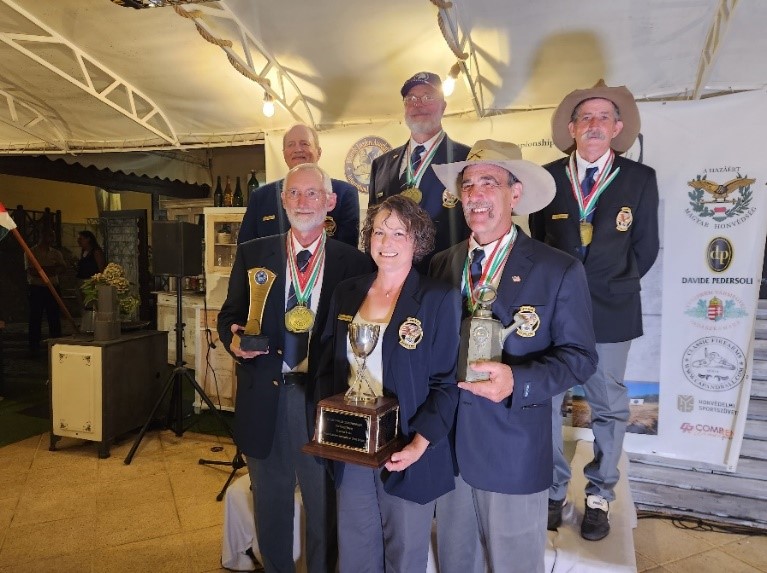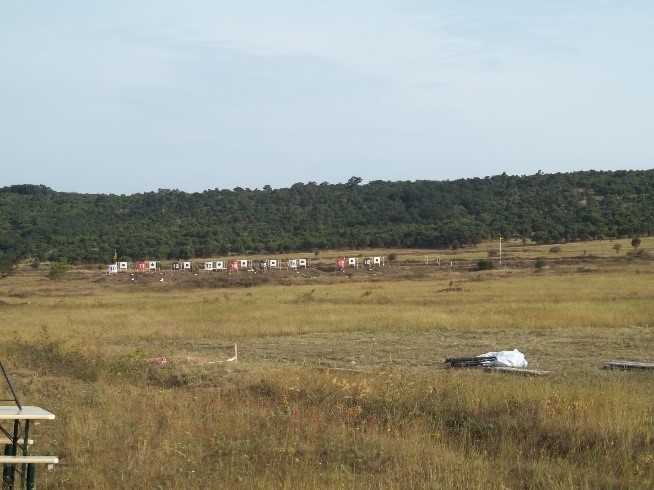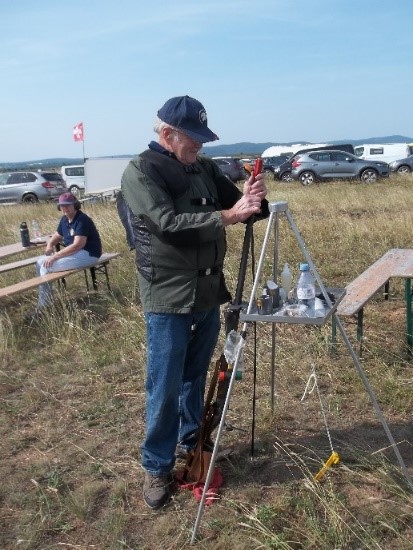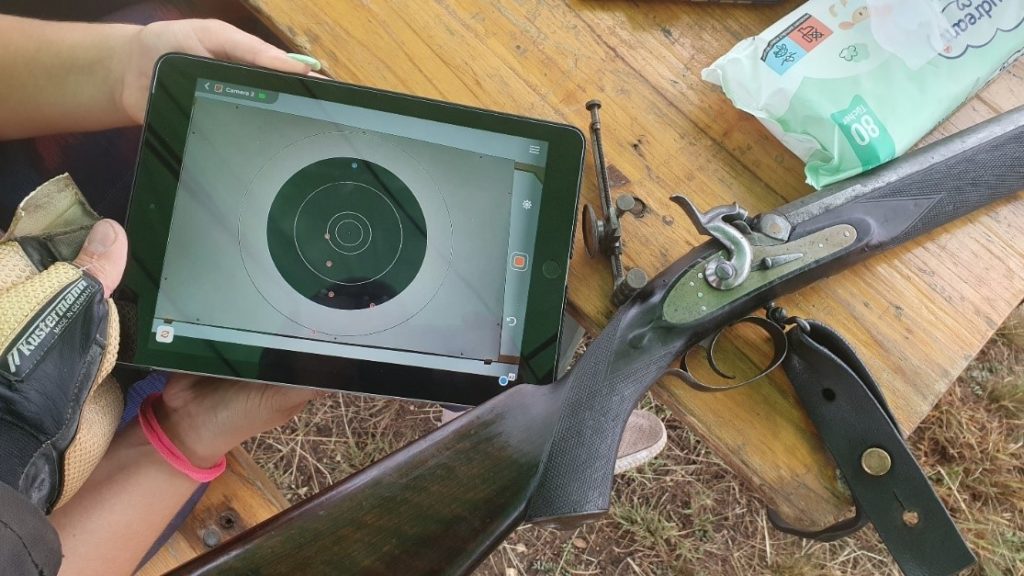Lee Shaver Captains U.S. Team, Brings Home Gold from Long-Range World Championships
The Championships were held by the Muzzle Loaders Association International Confederation (MLAIC) August 26 – September 2 in Veszprem Hungary, which is about two hours west of Budapest. There were fifty one shooters from the Austria, France, Germany, Hungary, Italy, Netherlands Norway, South Africa, Spain, Switzerland, and the United States. World championships are held every 2 years in different countries.
The match has two parts; mid-range with ten shots each for record at 300, 500, and 600 yards and long-range with 15 record shots each at 900 and 1,000 yards. Individual matches are in separate categories for original guns and replicas. Four-man team matches use both types of guns.
The U.S. International Muzzle Loading Team (USIMLT) long-range team captain, Lee Shaver, noted that because of the Covid pandemic there had been no world championships for 4 years and age-related retirements and health concerns about travel resulted in a need to rebuild the team. Shaver spent a couple of years working with and attempting to develop new shooters some of which were new to black powder and others with breach loader experience. “The breech loading sport is where we have traditionally found our most successful shooters, so I had hopes of being able to put together a decent team. We’ve recruited a number of shooters new to muzzle loading and did very well,” Shaver said.

Back row, left to right: Tony Martello, Steve Farringer, Chip Mate.
Front row: Back row left to right: Lee Shaver, Crystal Bentlage-Gerbitz team adjutant, and Dave Gullo.
Traveling by air with firearms, Overcoming Fubar
We met in Chicago to fly together to Hungary. We used British airways and very carefully followed instructions on how to travel with guns and ammunition (bullets only, obviously we had NO powder). When we got to Chicago the British Airways employee at the counter changed all the rules.
The morning after we arrived at our hotel in Veszprem we found that one of our team had no bullets, and his camera was gone from his bags. Another had only half the bullets for the match and a third had his rifle and bullets but no shooting gear. As it turns out the person at the counter in Chicago forced us to repack our bullets and the guys in the baggage inspection area confiscated and threw them away…. because they were packed wrong!?! At this point we had three of the five shooters who assumed they would not be shooting, Shaver said.
Shaver spent that first weekend calling in favors and by Sunday afternoon the team had borrowed bullets from the South African team, and a Hungarian organizer had brought over a box of new bullets, paper for patching, a cutter and cutting board, sizing dies, and equipment to use. The team worked till late Sunday night to get everything ready so we could shoot Monday morning. We also organized what equipment could be traded around so everyone had something to shoot with when it was their turn.
“I am very proud as captain to see them as team players that would do what was needed to make things work. That night we cut paper patches and sized bullets and did whatever was needed for each other. They made a solid effort that paid off.” Shaver said.
The Shooting Range … Rough Terrain Shooting At Its Worst
The range was not what you’d expect for an international competition. It is a nature preserve grassland and a NATO training facility. “There were times when you would get to your firing point and see that it had been used by tank that had turned on that spot. You had to be a contortionist to get into a reasonably steady shooting position,” Shaver said.
The Match Results
The targets were being scored with a camera system, and we found out the hard way that if your bullet passed through another hole, the camera system may not be able to locate it. There were several complaints about that at 300 yards. I had it happen once and a second time at 500 yards, but as the distances grew longer the problems with that happening went away.

In the individual match 300 yards Shaver was the high scoring American in 4th place with the rest of the team members being 4 to 10 points behind. But when they shot the 4-man team event later that day they pulled together to win the team distance.
The second day was 500 yards and Shaver had another “disappearing bullet hole.” Steve Farringer had the best score in 9th place. During the 500 yard team match the U.S. Team was 4th, but only four points behind the 1st place finishers.
At 600 yards Shaver won Gold in the individual match with the rest of the team seven to twelve points behind him, but when they shot the team target they won the distance. The team competitions are aggregate competitions so as a team the U.S. won Gold for the mid-range team match. Shaver was also awarded Gold for the mid-range individual aggregate.

At 900, Shaver won gold again, with Dave Gullo in 3rd for the Bronze medal, and Tony Martello, and Steve Farringer in 5th and 6th for certificates and Chip Mate in 10th. “We worked well together as a team and won the team distance by a half dozen points,” Shaver said.
The final individual target was at 1000 yards, where Shaver placed 4th, with Dave Gullo in 9th and the others team members a few points behind him.
During the team target we worked together so well that at least one of the other teams was filming us for future study. During that team target Dave and I worked together to shoot some remarkable scores in difficult conditions and followed by Steve and Tony with Chip reading the conditions for them. We won that distance by 48 points, which meant that we won the long range team event by a total of 62 points over 2nd place.
In the long range individual aggregate, Shaver won Silver with Dave Gullo in 5th, and the entire team placing in the top 12. In the individual grand aggregate, Shaver again won silver with Dave Gullo in 5th, and the entire team placing in the top 13. The U.S. Team won the team grand aggregate with an amazing lead of 81 points ahead of second place.
All totaled there were three individual gold medals, two silvers, and one bronze, plus three team gold medals for each of the team members, plus the team brought home all three of the team trophies.
“I am very proud of our team, and especially proud of our new guys that worked so hard to go from their first muzzle loading match in March to winning medals in a world championship only five months later,” Shaver said.
“We could not have accomplished what we did without all of us pulling together, from the shooters to their wives, and Mrs. Gerbitz too. It was a wonderful experience to take part in, even when things did not go well. I told my shooters many times over the last year that as captain I saw my first responsibility to make sure they have the best expereince possible, before, during, and after the match. “If you have a good experience you’ll do it again, and tell others how great it was. Give them a bad expereince and you’ll find you have no team next time. This team is already looking forward to next time.” Shaver said.
Long-range muzzle loading is one of the most challenging of all shooting disciplines and demands practice and commitment as well as some match experience to perform at high levels.

Despite the occasional “disappearing bullet hole” competitors felt the electronic target system was a great benefit. As Lee Shaver said, “Yes, they [score keepers] were sitting just behind the firing line at picnic tables, with one person running the tablet and another official scorer writing the scores down for each shot. We could walk over and see the location of each hit and verify our score and location. The camera could zoom in and you could look at an individual hole.
Long-range muzzle loading is one of the most challenging of all shooting disciplines and demands practice and commitment as well as some match experience to perform at high levels. But the sport, because of the investment in time, effort and commitment, is one of the most satisfying. For more information contact the Long Range Team captain Lee Shaver at longrangeml@gmail.com .